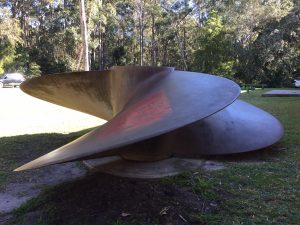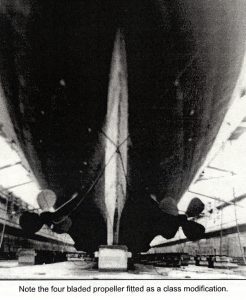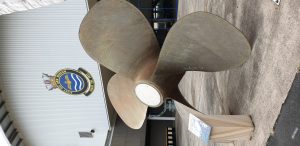- Author
- Editorial Staff
- Subjects
- Ship design and development, Naval technology
- Tags
-
- RAN Ships
- HMAS Sydney III
- Publication
- December 2019 edition of the Naval Historical Review (all rights reserved)
We recently became aware of two propellers from HMAS Sydney (III) not far away from one another in the Shoalhaven. One was at the recently named Jervis Bay Maritime Museum (ex-Lady Denman Museum) at Huskisson and the other at the Fleet Air Arm Museum at HMAS Albatross at Nowra. The first of these is three-bladed and the latter four-bladed. Discussions with those who had sailed in the carriers Sydney and HMAS Melbourne and dockyard workers who had refitted them confirmed that these ships did indeed have three-bladed propellers on their port shafts and four-bladed propellers on their starboard shafts. No further explanation was forthcoming other than that the ships had suffered vibration problems.
Aircraft Carrier Designs
It was not until 1938 that the Royal Navy (RN) commissioned HMS Ark Royal, its first purpose built aircraft carrier. She was followed by others of the Illustrious and Implacable classes. These ships were expensive and took immense resources in design and construction. As an interim measure the need for a number of Light Fleet Carriers (LFC) was identified. These ships were designed and constructed by commercial shipyards as an intermediate step between the full-sized fleet aircraft carrier and the much smaller Utility Escort Carriers built from mercantile hulls with limited capability.
The LFCs first comprised the Colossus class: HM Ships Colossus, Glory, Ocean, Venerable, Vengeance, Warrior, Theseus, and Triumph. In addition, two Aircraft Maintenance Ships HM Ships Perseus and Pioneer were laid down as Colossus class. These ships were followed by the redesigned LFCs of the Majestic class: HM Ships Majestic, TerribleI, Magnificent, Hercules, Leviathan and Powerful. The Light Fleet Carriers were designed as disposable warships, using available materials, with a planned three-year service life. They exceeded these expectations handsomely and later helped form the basis of Fleet Air Arms in a number of countries.
Engine configurations of both the Colossus and Majestic classes were similar. The machinery was arranged in two compartments each containing two Admiralty 3-drum boilers feeding a Parsons geared turbine which were staggered, with the starboard compartment forward of the port. They provided 40,000 shp (30,000 kW) to two shafts driving two 3‑bladed propellers giving the ships a maximum speed of 25 knots. This meant the starboard propeller shaft was longer than the port shaft, which may have led to torsional vibration causing extra stress to the starboard propeller shaft.
Pioneer commissioned in February 1945, sailed the next month to join the British Pacific Fleet in Australia as an Aircraft Repair Ship and was later used to ferry aircraft. Possibly during her trials (a date has yet to be established) she suffered a severe implosion in the forward machinery space caused by the snapping of the starboard propeller shaft due to the torque applied to the much longer shaft. During repairs her starboard propeller was replaced with a four-bladed unit; subsequently all ships of the Colossus and Majestic classes had four-bladed propellers fitted to their starboard shafts and no further problems were experienced.
Reference to the above is to be found in Australian Aircraft Carriers 1929-19822 written by the respected RAN shipwright the late Vince Fazio who had served in this class of ship. He states that his information was supplied in 1962 by Mr. A. A. C. Griffiths, OBE, from the Royal Corps of Naval Constructors, who specialised in carrier design and the associated problems.
Marine Propeller Design
The design of marine propellers is a complex matter best left to the experts but in general twin screw vessels have counter rotating propellers with identical specifications. The port propeller is usually left handed and the starboard propeller usually right handed. Three-bladed models were most commonly used by the RN as they give a higher maximum speed. However although slightly less efficient, four-bladed models can help reduce vibration and cavitation.

While ships are known to have been designed with a mix of three- and four-bladed propellers this is usually when there is a centre engine linked to a large four-bladed propeller and two wing engines have smaller three-bladed propellers. No known original designs have been made with the modified system employed in the Colossus and Majestic classes.
This may lead to the conclusion that the three- and four-bladed combination found in the Colossus and Majestic classes was a short-term fix following a critical design failure in Pioneer. This proved so successful that the rest of the ships in these classes were retrofitted and this in turn provided a successful outcome.
Leyland Wilkinson, one of our stalwarts with an immense amount of experience at Garden Island Dockyard, has managed to dig up some details of the Melbourne/Sydney propellers from his old workshop notebooks. These give the following specifications:
| Propellers No 2 | J. Stone & Co3 | |
| Port | Starboard | |
| Diameter | 14’ 0” | 14’ 0” |
| No of Blades | 3 | 4 |
| Pitch | 14’ 3” | 13’ 7” |
| Developed Surface Blades | 90 sq ft | 99.3 sq ft |
| Projected Surface Blades | 74.82 sq ft | nk |
| Diameter of Boss (Max) | 3’ 0” | 3’ 0” |
| Blade Thickness Root | 9” | 6¾” |
| Blade Thickness Tip | ⅝” | 0.43” |
| Keys Off | 2 | 2 |
| Material | Manganese Bronze | Manganese Bronze |
| Direction of Rotation (Ahead) | Outward | Outward |
| Propeller Shaft – length4 | 28’ 5⅛” | 28’ 5⅛” |

Leyland also provides some common sense argument to the propeller configuration in these ships using the following examples.
In 1831 a detachment of troops from the 60th Rifle Corps were marching four abreast over Broughton Bridge, a suspension bridge spanning the River Irwell near Manchester. It should be noted that the Rifle Corps of light infantry march at 140 paces per minute as opposed to normal infantry at 120 paces per minute. The bridge began to vibrate and then collapsed under them, reportedly due to ‘Mechanical Resonance’ induced by the troops marching quickly in step. As a result, the British Army issued an instruction that henceforth troops should ’Break Step’ when crossing bridges, which remains the current practice.
Could this effect also be applied to the regular beating of equal, multiple propeller blades, as the cause of vibration in lightly built ships driven by powerful engines?
High propeller speeds can also produce ‘cavitation’ by the propeller trying to drive the water astern faster than it can reach the blades from forward, thus forming vacuum pockets. When these collapse, water falls in suddenly and hits the blades with violent hammer like blows. “Change the beat and save the ship!”
RAN Service
In July 1947 the Commonwealth Government approved the formation of the Fleet Air Arm and the acquisition of two Majestic class Light Fleet Carriers. Because the first of these, Terrible, was nearing completion her construction was finished without major modification and she commissioned as HMAS Sydney on 16 December 1948. As her sister Majestic, which was to become HMAS Melbourne, was still undergoing modifications, another LFC, HMS Vengeance,was lent to the RAN as HMAS Vengeance from 1952 to 1955. When Vengeance was returned to the RN her crew transferred to Melbourne which was commissioned on 26 October 1955.

The ‘Terrible’ Sydney had an exciting career completing two operational missions to Korea as part of United Nations forces opposing the invasion of South Korea, and later when converted as a Fast Troop Transport, supporting Australian forces during the Vietnam War. She finally paid off on 12 November 1973 and in 1975 was sold for scrapping in South Korea.
The ‘Majestic’ Melbourne with her angled flight deck, steam catapult and mirror assisted landing system was able to accept later generation and heavier aircraft. Melbourne was a great asset in developing a balanced fleet but she saw no wartime action. It is unfortunate she is remembered for her part in the sinking of two Allied warships. Melbournedecommissioned on 30 June 1982 and was sold for scrapping in China in 1985.
Should any of our readers have any further information on the history of the strange propeller configurations of Sydneyand Melbourne we should be pleased to hear.
Notes:
- While the remainder of the LFCs were constructed at commercial yards Terrible was built at the Devonport Naval Dockyard.
- Fazio, Vince, Australian Aircraft Carriers 1929-1982, Naval Historical Society of Australia, Sydney, 1997.
- In 1831 Josiah Stone established an engineering workshop specialising in producing cast copper nails for the Thames side shipbuilding industry. By 1881 the company (J. Stone & Co.) had expanded, becoming a specialist in casting large copper propellers. With wartime bombing the company moved to Birkenhead in 1941. During WWII Stone & Co. produced 22,000 propellers for the Royal Navy. Stone Marine Group remains in business providing worldwide services to the shipping industry.
- The listed lengths of the two propeller shafts are identical but this only concerns the last section of shafting (sometimes referred to as tail shafts). The length of the total line of shafting to the different engine rooms is not listed, which were made up of Thrust, Intermediate and Propeller shafts coupled together. As discussed in the above paper the overall length of the starboard propeller shafting was longer than that of the port propeller shafting.




